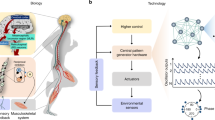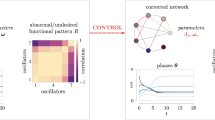Abstract
This article proposes a network system composed of oscillators and capacitive couplers as an abstract neural circuit model for use in elucidating functional combinations of neural elements. The capacitive couplers produce changes in the interactions between the oscillators and enable various functions that the oscillators alone cannot realize. The functions added by these capacitive couplers include NOR-based logic operations, a falling edge detector, an astable multivibrator, and sequential pattern generation. The results of this study suggest that the incorporation of capacitive functions in an oscillatory network system is a beneficial means of extending the functionality of the system.
Similar content being viewed by others
References
S. Grillner, O. Ekebergb, A. E. Manira, A. Lansner, D. Parker, J. Tegner, P. Wallen: “Intrinsic function of a neuronal network — a vertebrate central pattern generator,” Brain Research Reviews, 26, 184/197, 1998.
H. Kimura, Y. Fukuoka, A. H. Cohen: “Adaptive dynamic walking of a quadruped robot on natural ground based on biological concepts,” The International Journal of Robotics Research, 26(5), 475/490, 2007.
F. Ruffier, S. Viollet, S. Amic, N. Franceschini: “Bio-inspired optical flow circuits for the visual guidance of micro air vehicles,” Proceedings of the International Symposium on Circuits and Systems 2003, 3, 846/849, 2003.
T. Hashimoto, T. Sato, M. Nakatsuka, M. Fujimoto: “Evolutionary constructive approach for studying dynamic complex systems,” In Giuseppe Petrone and Giuliano Cammarata, editors, Recent Advances in Modelling and Simulation, chapter 7.I-Tech Books, 2008.
Y. Obara: “Bombyx mori mating dance: an essential in locating the female,” Applied Entomology and Zoology, 14(1), 130/132, 1979.
W. Li, J.A. Farrell, R.T. Cardé: “Tracking of fluid-advected odor plumes: Strategies inspired by insect orientation to pheromone,” Adaptive Behavior, 9(3–4), 143/170, 2001.
T. Lochmatter, A. Martinoli: “Tracking odor plumes in a laminar wind field with bio-inspired algorithms,” Proceedings of ISER 2008, 54, 473/482, Springer, 2009.
R. Kanzaki, N. Sugi, T. Shibuya: “Self-generated zigzag turning of Bombyx mori males during pheromone-mediated upwind walking,” Zoological Science, 9, 515/527, 1992.
S. Strogatz: “Sync: The Emerging Science of Spontaneous Order,” Hyperion, 2003.
M. Stopfer, M. Wehr, K. Macleod, G. Laurent: “Neural dynamics, oscillatory synchronisation, and odour codes,” In B. S. Hansson, editor, Insect Olfaction, 163/180, Springer, 1999.
T. Funato, D. Kurabayashi, M. Nara, H. Aonuma: “Switching mechanism of sensor-motor coordination through an oscillator network model,” IEEE Transactions on Systems Man and Cybernetics Part B-Cybernetics, 38(3), 764/770, 2008.
J. Perez-Orive, M. Bazhenov, G. Laurent: “Intrinsic and circuit properties favor coincidence detection for decoding oscillatory input,” Journal of Neuroscience, 24(26), 6037/6047, 2004.
Z. Li: “A neural model of contour integration in the primary visual cortex,” Neural Computation, 10, 903/940, 1998.
F.C. Hoppensteadt, E.M. Izhikevich: “Oscillatory neurocomputers with dynamic connectivity,” Physical Review Letters, 82(14), 2383/2386, 1999.
T Moriyama, D. Kurabayashi: “An oscillator network with a temporary memory function,” Proceedings of ROBIO 2008, 2024/2029, 2009.
K. G. Pearson, C. R. Fourtner: “Nonspiking interneuron in walking system of the cockroach,” Journal of Neurophysiology, 38(1), 33/52, 1975.
M. Burrows: “The control of sets of motoneurones by local interneurones in the locust,” Journal of Physiology, 298(1), 213/233, 1980.
M. Takahata, A. Takashima, R. Hikosaka: “Information processing by nonspiking interneurons: passive and active properties of dendritic membrane determine synaptic integration,” Biosystems, 58(1–3), 143/149, 2000.
M. Takahata, M. Murayama: “Multiple gate control of the descending statocyst-motor pathway in the crayfish Procambarus clarkii Girard,” Journal of Comparative Physiology A, 170(4), 463/477, 1992.
W.J. Heitler, K.G. Pearson: “Non-spiking interactions and local interneurones in the central pattern generator of the crayfish swim-meret system,” Brain Research, 187(1), 206/211, 1980.
D.H. Paul, B. Mulloney: “Nonspiking local interneuron in the motor pattern generator for the crayfish swimmeret,” Journal of Neurophysiology, 54(1), 28/39, 1985.
T. Nagayama, M. Takahata, M. Hisada: “Functional characteristics of local non-spiking interneurons as the pre-motor elements in crayfish,” Journal of Comparative Physiology A, 154(4), 499/510, 1984.
A.T. Winfree: “Biological rhythms and behavior of populations of coupled oscillators,” Journal of Theoretical Biology, 16(1), 15/42, 1967.
J.T. Ariaratnam, S.H. Strogatz: “Phase diagram for the Winfree model of coupled nonlinear oscillators,” Physical Review Letters, 86(19), 4278/4281, 2001.
Y. Kuramoto: “Chemical Oscillations, Waves, and Turbulence,” Springer, 1984.
S. Wada, R. Kanzaki: “Neural Control Mechanisms of the Pheromone-Triggered Programmed Behavior in Male Silkmoths Revealed by Double-Labeling of Descending Interneurons and a Motor Neuron,” Journal of Comparative Neurology, 484, 168/182, 2005.
R. Kanzaki, T. Shibuya: “Descending protocerebral neurons related to the mating dance of the male silkworm moth,” Brain Research, 377, 378/382, 1986.
Y.X. Li, Y.Q. Wang, R. Miura: “Clustering in small networks of excitatory neurons with heterogeneous coupling strengths,” Journal of Computational Neuroscience 14(2), 139/159, 2003.
Author information
Authors and Affiliations
Corresponding author
About this article
Cite this article
Moriyama, T., Kurabayashi, D. Pattern generation by network composed of oscillators and capacitive couplers. Paladyn 2, 36–43 (2011). https://doi.org/10.2478/s13230-011-0014-8
Received:
Accepted:
Published:
Issue Date:
DOI: https://doi.org/10.2478/s13230-011-0014-8




